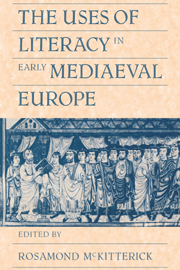Book contents
- Frontmatter
- Contents
- List of illustrations
- Contributors
- Preface
- Abbreviations
- Introduction
- 1 Literacy in Ireland: the evidence of the Patrick dossier in the Book of Armagh
- 2 Anglo-Saxon lay society and the written word
- 3 Administration, law and culture in Merovingian Gaul
- 4 Literacy and the papal government in late antiquity and the early middle ages
- 5 Literacy and the laity in early mediaeval Spain
- 6 Aspects of mediaeval Jewish literacy
- 7 Writing in early mediaeval Byzantium
- 8 Literacy displayed: the use of inscriptions at the monastery of San Vincenzo al Volturno in the early ninth century
- 9 Royal government and the written word in late Anglo-Saxon England
- 10 Literacy in Carolingian government
- 11 Text and image in the Carolingian world
- Conclusion
- Index
8 - Literacy displayed: the use of inscriptions at the monastery of San Vincenzo al Volturno in the early ninth century
Published online by Cambridge University Press: 07 December 2009
- Frontmatter
- Contents
- List of illustrations
- Contributors
- Preface
- Abbreviations
- Introduction
- 1 Literacy in Ireland: the evidence of the Patrick dossier in the Book of Armagh
- 2 Anglo-Saxon lay society and the written word
- 3 Administration, law and culture in Merovingian Gaul
- 4 Literacy and the papal government in late antiquity and the early middle ages
- 5 Literacy and the laity in early mediaeval Spain
- 6 Aspects of mediaeval Jewish literacy
- 7 Writing in early mediaeval Byzantium
- 8 Literacy displayed: the use of inscriptions at the monastery of San Vincenzo al Volturno in the early ninth century
- 9 Royal government and the written word in late Anglo-Saxon England
- 10 Literacy in Carolingian government
- 11 Text and image in the Carolingian world
- Conclusion
- Index
Summary
The monastery of San Vincenzo on the Volturno is situated at the head of the Volturno valley, a little more than 1 kilometre distant from the source of the river. It lies some 25 kilometres north of the old Roman town of Venafrum, modern Venafro, and about 30 kilometres north-east of Montecassino, across the Mainarde range of mountains. Founded in the first years of the eighth century, by three young men of noble birth from Benevento, it grew in size and fame, and became, for a relatively short period, one of the great monasteries of Europe. Contemporary sources refer to the exceptional size of the community in the closing years of the eighth century. In the later ninth century its fortunes began to decline, and in 881 it was sacked by an army of Saracens from North Africa, which had been harrying much of southern Italy for more than twenty years. The monks returned to San Vincenzo in 914, after thirty-three years of exile in Capua. The damaged buildings were gradually repaired and reconstructed, but the monastery never regained its former size and reputation. Finally, in the later eleventh century new monastic buildings were erected, and subsequently, under the Abbots Gerard and Benedict the main abbey church of San Vincenzo was completely rebuilt.
- Type
- Chapter
- Information
- The Uses of Literacy in Early Mediaeval Europe , pp. 186 - 225Publisher: Cambridge University PressPrint publication year: 1990



